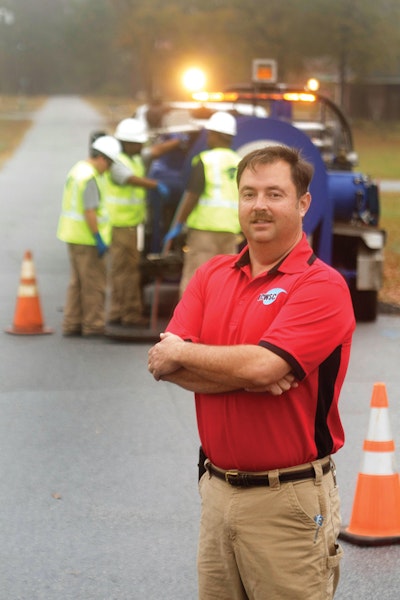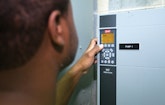
Interested in Infrastructure?
Get Infrastructure articles, news and videos right in your inbox! Sign up now.
Infrastructure + Get AlertsSanitary sewer overflows were a significant problem in Laurens County, S.C., where roots and grease choked the clay sewers servicing textile mill villages built in the 1930s. A solution was needed, and workers from the wastewater collection division of the county Water and Sewer Commission took charge.
In 2004, the commission participated in a voluntary capacity, management, operations and maintenance self-audit, and put wastewater collection system manager Gene Steele in charge.
“Our goal was to stop responding to calls about kids playing in sewage running down the streets and take an active role in preventing overflows,” he says.
Steele organized the collection of GPS data, a system assessment and prioritization of repairs; however, the challenges he faced were rooted in history and poverty. Mill companies owned everything in the towns including water and sewer lines, which they ran wherever they pleased, creating easement problems for workers today.
Most customers are in a low-income bracket, making it difficult to raise sewer rates. “I believe we do more with less than anybody else in the state, and we pride ourselves on those accomplishments,” says Steele. The South Carolina Rural Water Association agreed, naming him the 2011 Wastewater Collection Operator of the Year.
Rural restrictions
Steele oversees two 18- to 36-inch clay gravity trunk lines totaling 50 miles, 78 miles of gravity lines including 4- and 6-inch service laterals, 18 lift stations, 28 miles of force main, 1,200 manholes, and 48 air release valves. The county’s rural nature restricts sewer service.
Smaller city pipes radiate out to the trunk lines encircling the city limits. The largest collection system serves the mill town of Joanna; other collection systems serve satellite communities including Laurens. Wastewater flows to the 2.75 mgd Clinton/Joanna activated sludge treatment plant serving 13,000 people.
“The treatment area covers 37 square miles, but the collection system covers only five square miles,” says Steele. “The city maintains the small lines. My seven-person crew, operating on $400,000 a year, maintains everything outside the city limits.”
Roughly 90 percent or 140 miles of the system, mainly in Joanna, is old clay pipe with joints every two feet. When grease came in contact with the mortar, it dissolved the cement and enabled serious root intrusion. Steele assigned technicians Willie Cohens and Andy Vaughn to clean lines for nine months every year. He had no money to replace the pipes.
Appropriate tools
The commission bought a trailer-mounted 16 gpm/4,000 psi Harben jetter from Jet Vac with a 1/2-inch hose and Warthog nozzle from StoneAge. It also bought a trailer-mounted PipeHunter combination sewer cleaner with the Jet Eye inspection system.
“If we can’t clear the roots with the Harben, we use the PipeHunter,” says Steele. “Put a chain flair on a 3/4-inch hose fed by a 50 gpm/3,000 psi pump and it cleans like crazy.”
The crew uses the smaller Harben in backyards and confined areas. The bigger, heavier PipeHunter usually stays on the road. If they must bring it into a yard, they leave the water tank empty to reduce weight.
“We pump water to it from a trailer-mounted 1,500-gallon nurse tank,” says Steele. “We learned that the hard way after having to go back and repair lawns.”
For impossible root and grease blockages, the crew uses a trailer-mounted sewer rodder with 600 feet of 3/8-inch Blu-Steel sectional rods 3 feet long. Working manhole to manhole on an 8-inch line, Steele runs a 4-inch root saw upstream to cut a pilot hole. When the worker at the other manhole signals its arrival, Steele shuts down the machine while the technician replaces the saw with a 6-inch version, then Steele reverses the process.
“Pulling backward enables me to put more tension on the rods without breaking them,” says Steele. “We don’t want to dig up the pipe.” The commission limits the use of chemicals to kill roots because of the expense, preferring to cut the hot spots annually. The gravity lines are on a five-year cleaning cycle.
What do we own?
Steele supervised the collection of GPS data on gravity sewers and lift stations, assisted in creating a Web-based GIS application for the department, and updates the database with new infrastructure. He is now assessing the pipes.
The crew uses a trailer-mounted CUES inspection system with pan-and-tilt camera on an Ultra Shorty transporter with 450 feet of cable.
“Our longest runs were 750 feet launching from the downstream manhole, then back down the upstream manhole,” says Steele. “When we scheduled five miles of 8-inch sewer in Joanna with limited access, I knew the inspection would take three months.”
Unwilling to tie up his crew for that long, Steele did something that nobody else in the region had tried. He rented a fleet of Solo cameras from RedZone Robotics and completed the project in one week.
“Rights-of-way were one of our biggest concerns,” he says. “We have lines under sidewalks, in alleys, and under sheds or home additions.
“With Solo, a technician operates four battery-powered robots simultaneously from one manhole, eliminating easement access issues and minimizing public disruption.”
His next challenge will be inspecting the trunk lines and identifying point repairs.
Testing the water
The commission has little experience with trenchless technology and is testing different methods to learn what works best. One project included bursting 400 feet of 8-inch sewer and replacing it with high-density polyethylene pipe.
“We don’t own the alleys where the sewers run, so we’re gradually relocating them to the streets,” says Field. “We’re looking at pipe bursting to avoid tearing up the asphalt and then replacing it afterward.”
In 2011, the department received its first grant for several cured-in-place pipe rehabilitation projects, but there is a catch.
Although the commission identified the sections at highest risk, the grant criteria determine the priority. “It all depends on which homeowners will fill out the paperwork, share personal information, and help us meet the criteria,” says Field.
The commission raised all the revenue it could through fees before resorting to grants. “Our rates are already above the state average and probably the Southeast average,” says Anderson. “We’re almost $6 per thousand gallons with a $7 base fee for no usage. For customers on fixed incomes, that’s a hefty sewer bill.”
Most replacement projects still use open-cut. The longest to date replaced 1,500 feet of 6-inch force main and set five manholes in Joanna.
“The line ran through a deserted mill property and wasn’t easy for businesses to access from the main road, so we abandoned it and laid a new one,” says Steele.
Pump station upgrades
Lift stations were another source of overflows during 4- to 5-inch rainfalls and especially where one station fed another and both ran too much. Steele had technicians camp out all night to turn the pumps on and off and control the flow. When funds became available, he took action.
Steele equipped all the stations with SCADA systems from MISSION Communications, then upgraded the pumps and added Danfoss variable-frequency drives on five stations to lower the electric bill. He installed Caterpillar emergency diesel generators at the smaller stations and Katolight brand generators from MTU Onsite Energy at the large wet wells, and purchased GE Zenith automatic transfer switches to alternate between electric and standby power. Should everything fail, Steele installed bypass piping at major stations.
The 700- to 1,200-gallon wet wells, installed when mills discharged 500,000 gpd, had bar screens. An operator descended 25 feet down a ladder in a confined space to rake the screen. “We had a lot of problems with companies flushing trash down the toilets,” says Steele. “The worst offenders are prisoners in the county jail.”
In 2011, he replaced the screens with Model 3000 Muffin Monster grinders from JWC Environmental. “They cut up everything and make maintenance much safer for my operators,” says Steele. “Half the lift stations have Gorman-Rupp suction pumps or small submersibles. If we maintain them, we may avoid upgrading for 30 years.”
Manhole rehabilitation
Most manholes in the villages are brick and mortar, while the trunk lines have precast structures. “Hydrogen sulfide had eroded the concrete so badly that we figured on replacing them,” says Steele.
Instead, the commission purchased SewperCoat equipment from Kerneos.
“We rehabilitated 300 manholes on the gravity lines in 2006 and saved a bundle over buying new ones,” says Steele. “The coating looks just as good as the day we applied it.”
Steele then turned his attention to the village manholes. Crews use the Harben jetter to wash the structures, occasionally spraying them with degreaser to clean the surface before spraying on and brushing down the coating.
“The interior has to be wet,” says Steele. “The wetter it is, the longer it takes the coating to dry, but it has great structural integrity.”
Steele’s final source of SSOs was leaking air release valves. In 2006, he scheduled them for quarterly disassembling and cleaning. Until Steele ran out of parts, he used to rebuild the valves when they failed. Today, he replaces them with D-025 SB kinetic air/vacuum valves from A.R.I. USA.
“I won’t use anything else because they are easy to service and that reduces the time we are in a confined space,” he says.
The only SSOs now are from broken force mains, and the commission uses grant dollars when available to upgrade the worst sections.
“Gene and his crew have done a great job reducing overflows from blockages to zero,” says Field. “However, what we need to take our efforts to the next level is a growing customer base. Our biggest challenge is lack of growth.”










